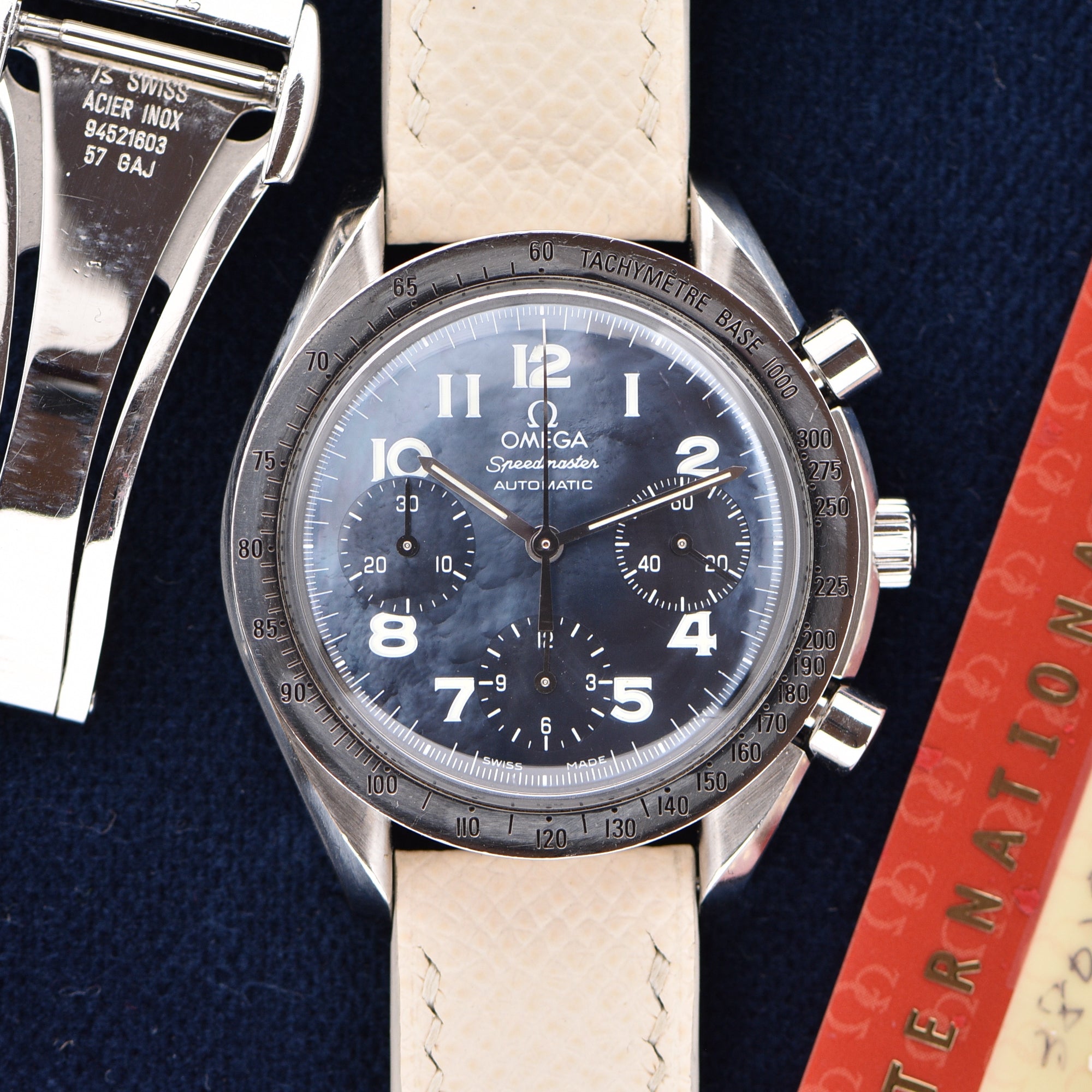
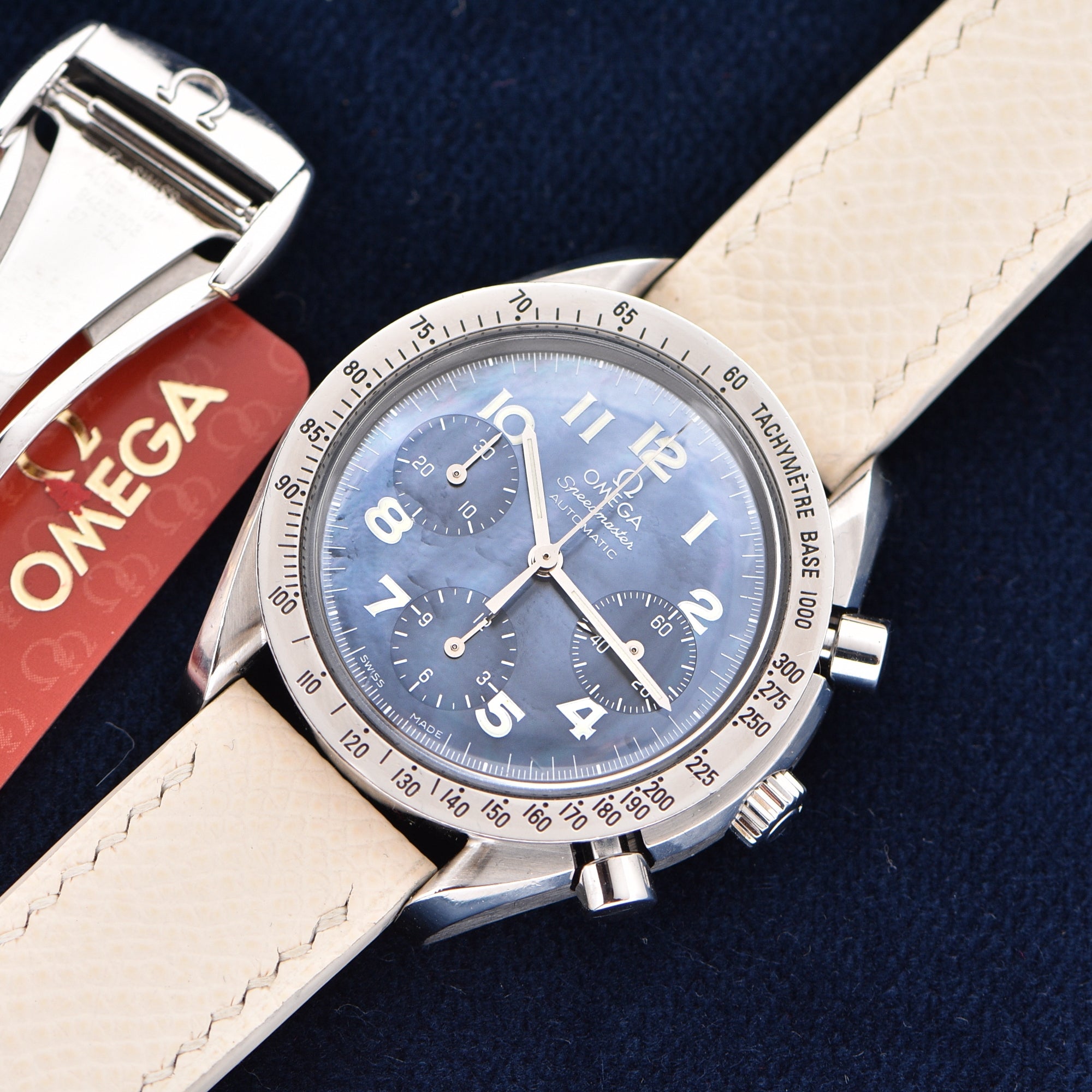
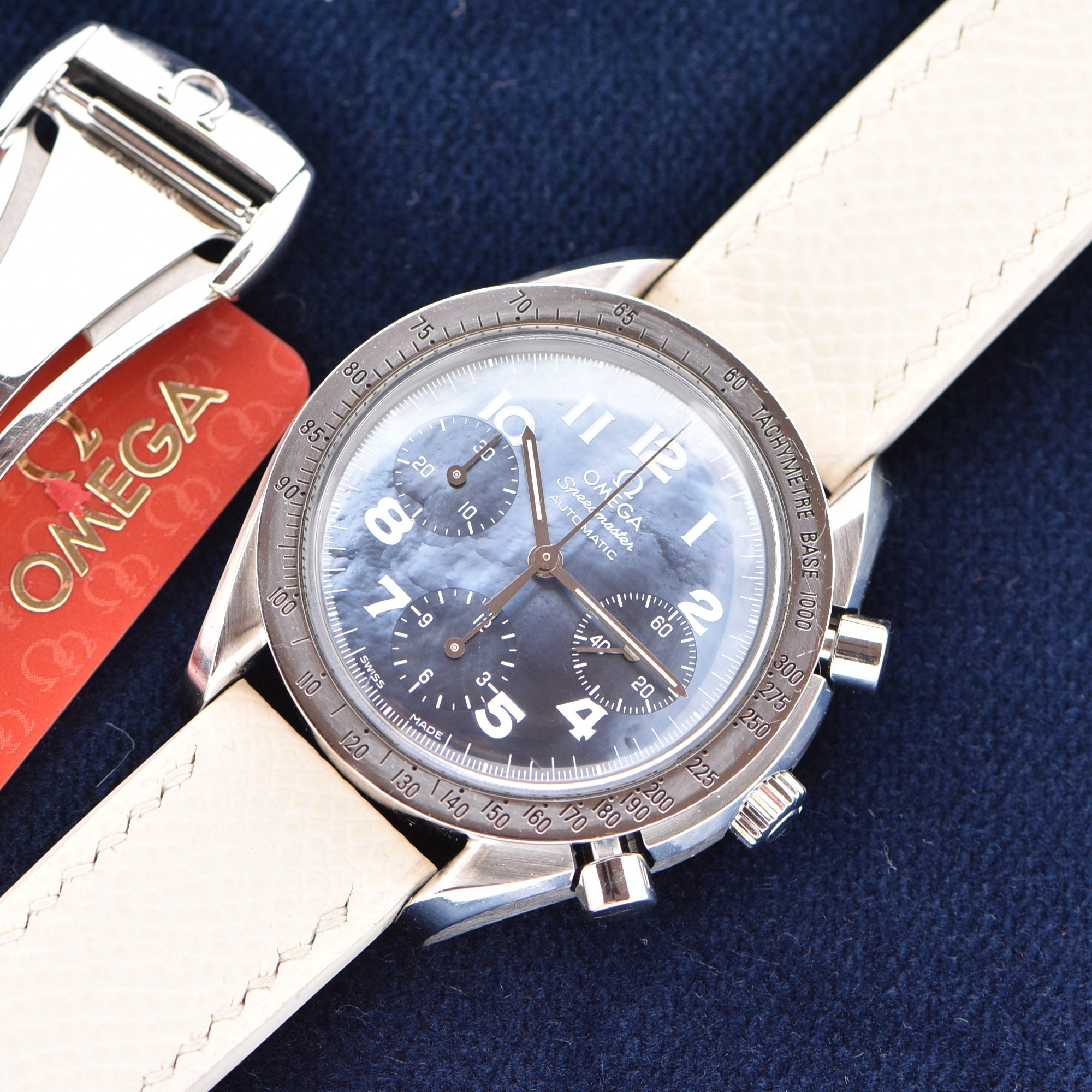
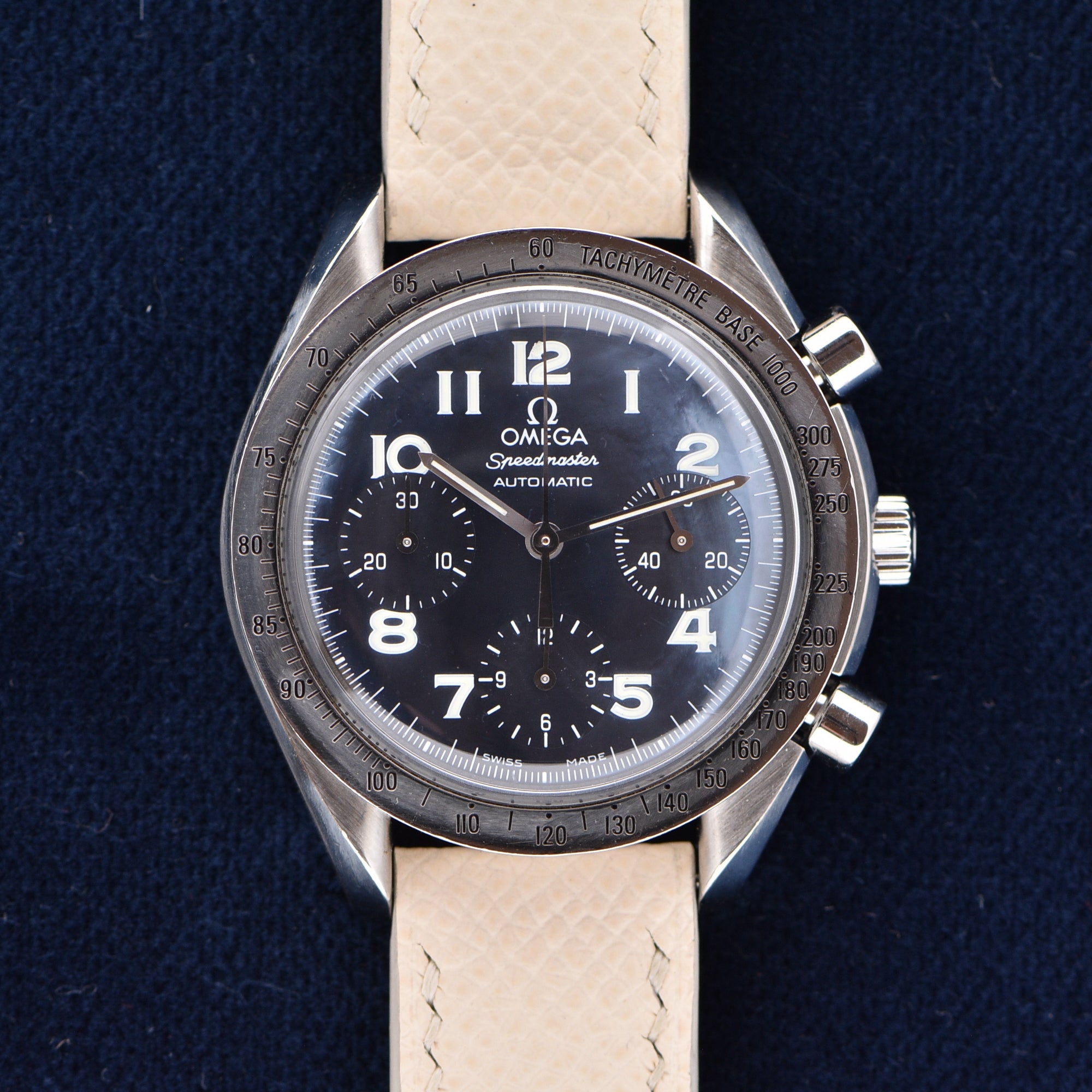




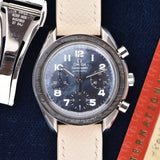
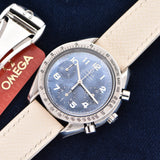
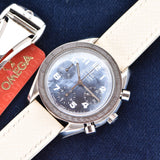
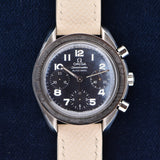
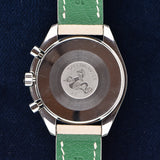
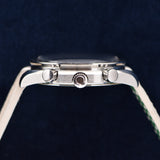


1998 Omega Speedmaster Reduced Mother Of Pearl - Box & Papers
- 3802.73.51
- Boxes, Papers, Buckle
- Specifications
- The Story
- The Brand
Year: 1998
Model: Speedmaster
Case Diameter: 39mm
Lug to Lug: 45mm
Case: Stainless Steel
Dial: Pearl
Movement: Automatic
Condition
The case does have signs of wear but nothing major. The bezel is still nice and clear with some scratches from normal wear. The pearl dial has no cracks. The watch comes with the original box, which has dried up like many boxes from the era but is still in one piece. The watch also comes with the original buckle and warranty card.
The Omega Speedmaster range, a legendary collection of iconic chronographs, has captured the hearts of watch enthusiasts worldwide. The Speedmaster Reduced, introduced in the 1980s, aimed to cater to individuals with smaller wrists or those seeking a more wearable timepiece. Despite its reduced dimensions, the Speedmaster Reduced retained the signature elements that made the original Speedmaster an emblem of horological excellence.
The history of the Omega Speedmaster dates back to 1957 when the first Speedmaster model was launched. Designed as a robust and precise chronograph for motorsport enthusiasts, the Speedmaster quickly caught the attention of NASA and underwent rigorous testing for space missions. In 1965, it was officially chosen by NASA as the official watch for all manned space missions, making it the first watch to be worn on the moon during the Apollo 11 mission in 1969. This historic association with space exploration earned the Speedmaster the nickname "MoonWatch," solidifying its place as one of the most revered timepieces in history.
The Speedmaster Reduced shares the same pedigree and heritage as the MoonWatch but has some notable differences. The most apparent distinction lies in its size. The Speedmaster Reduced features a 39mm case, which is smaller than the 42mm size of the MoonWatch. This reduced size makes it more suitable for wearers with smaller wrists or those who prefer a more restrained and comfortable fit. Additionally, the Speedmaster Reduced houses an automatic movement, while the MoonWatch is equipped with a manual-winding movement. The automatic movement in the Reduced allows the watch to self-wind through the natural motion of the wrist, eliminating the need for manual winding daily. On the other hand, the manual-winding movement in the MoonWatch has a unique charm for watch enthusiasts who appreciate the traditional and tactile aspect of winding their timepieces.
The choice between the Omega Speedmaster Reduced and the MoonWatch ultimately comes down to personal preference and wrist size. Collectors and enthusiasts who appreciate the historical significance of the MoonWatch and its larger size may lean towards the classic model, while those seeking a more practical and everyday wearable timepiece with a smaller case size might find the Omega Speedmaster Reduced to be the perfect fit. Both watches exemplify Omega's commitment to craftsmanship, precision, and innovation, making them enduring symbols of horological excellence.
The example we have here is a limited release of the blue pearl dial Speedmaster Reduced. Only a handful of these were made, out of all the pearl dials, this is one of the more uncommon examples.
Omega, a Swiss watchmaker founded in 1848, has a rich history of innovation and precision. The company's vision was carried on by its sons Louis-Paul and César, who pioneered full watch production under the brand's roof. In 1894, the company unveiled the world's first mass-produced, interchangeable watch movement, the Omega Calibre, which streamlined production and propelled the brand to international fame.
As the 20th century began, Omega watches became at the forefront of timekeeping technology and revolutionized sports watches with their precision. The Olympic Games provided an ideal stage for Omega to demonstrate its exceptional timekeeping abilities. In 1932, Omega began its role as Official Olympic Timekeeper, starting an enduring partnership spanning over 80 years. With each Games, Omega introduced groundbreaking timekeeping innovations, such as the first photo finish camera at the 1948 London Olympics.
Omega's contributions to spaceflight began in 1962 when the Omega Speedmaster became the first watch worn in space on Mercury-Atlas 6. Its defining moment came in 1969 with the Apollo 11 moon landing, where Buzz Aldrin stepped onto the moon wearing his trusty Omega Speedmaster Moonwatch. The company played an indispensable role in NASA's pioneering '60s space missions, including the Apollo 13 mission, where the Speedmaster timed the engine burn, ensuring the crew's safe descent to Earth.
Omega's cultural impact extends into pop culture through a long-running cinematic partnership with James Bond Movies. Since 1995's GoldenEye, James Bond has sported Omega watches on the silver screen, wearing the Seamaster Diver 300M and the rugged Omega Seamaster Planet Ocean.
Omega remains dedicated to exploring new technological frontiers today, with innovations like the battery-free Pictograms model, wearable tech collaborations, and energy-harnessing movements driving progress and cementing its place in history.
1998 Omega Speedmaster Reduced Mother Of Pearl - Box & Papers
Authenticity Guaranteed
All our watches are carefully inspected to insure and guarantee the authenticity.
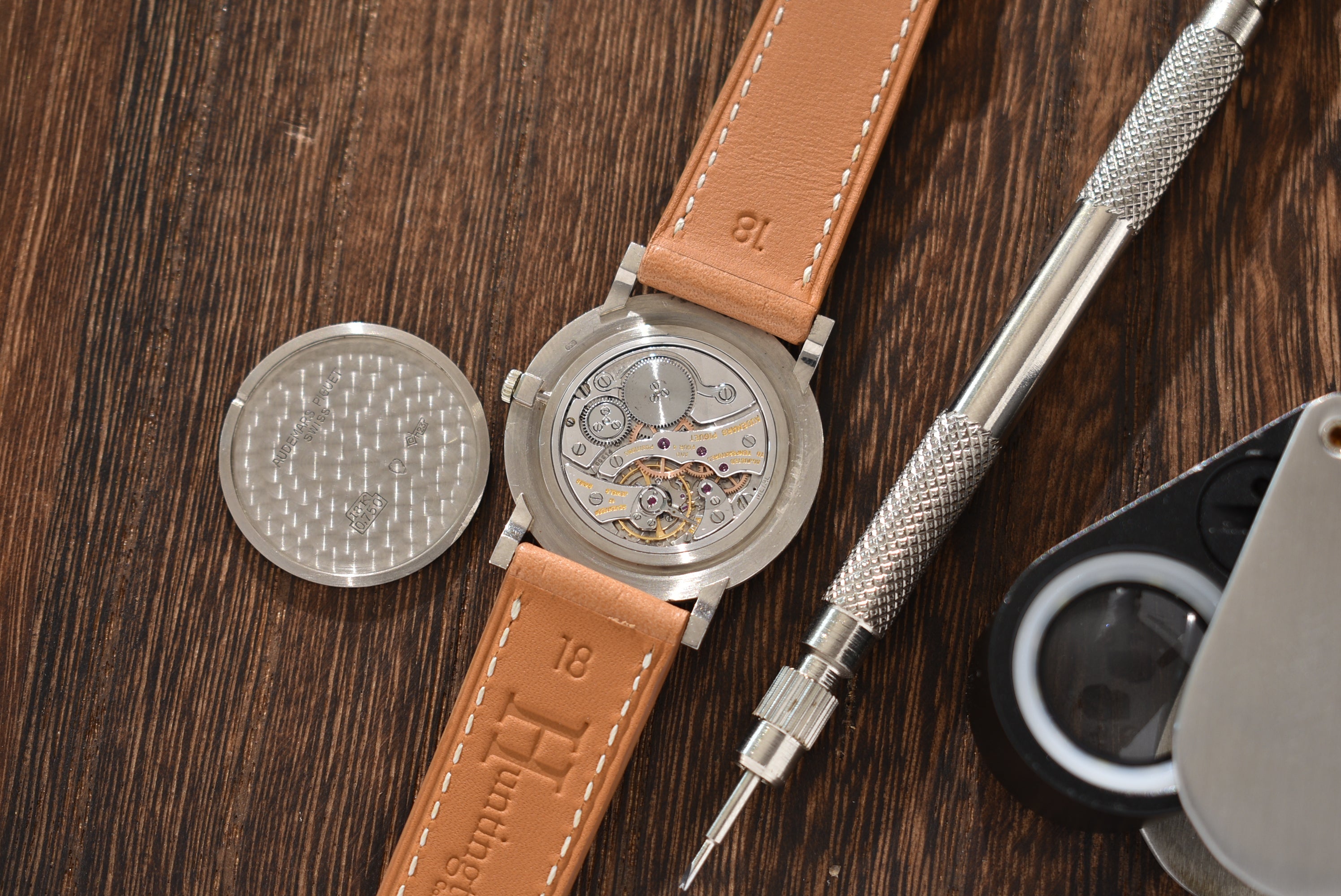
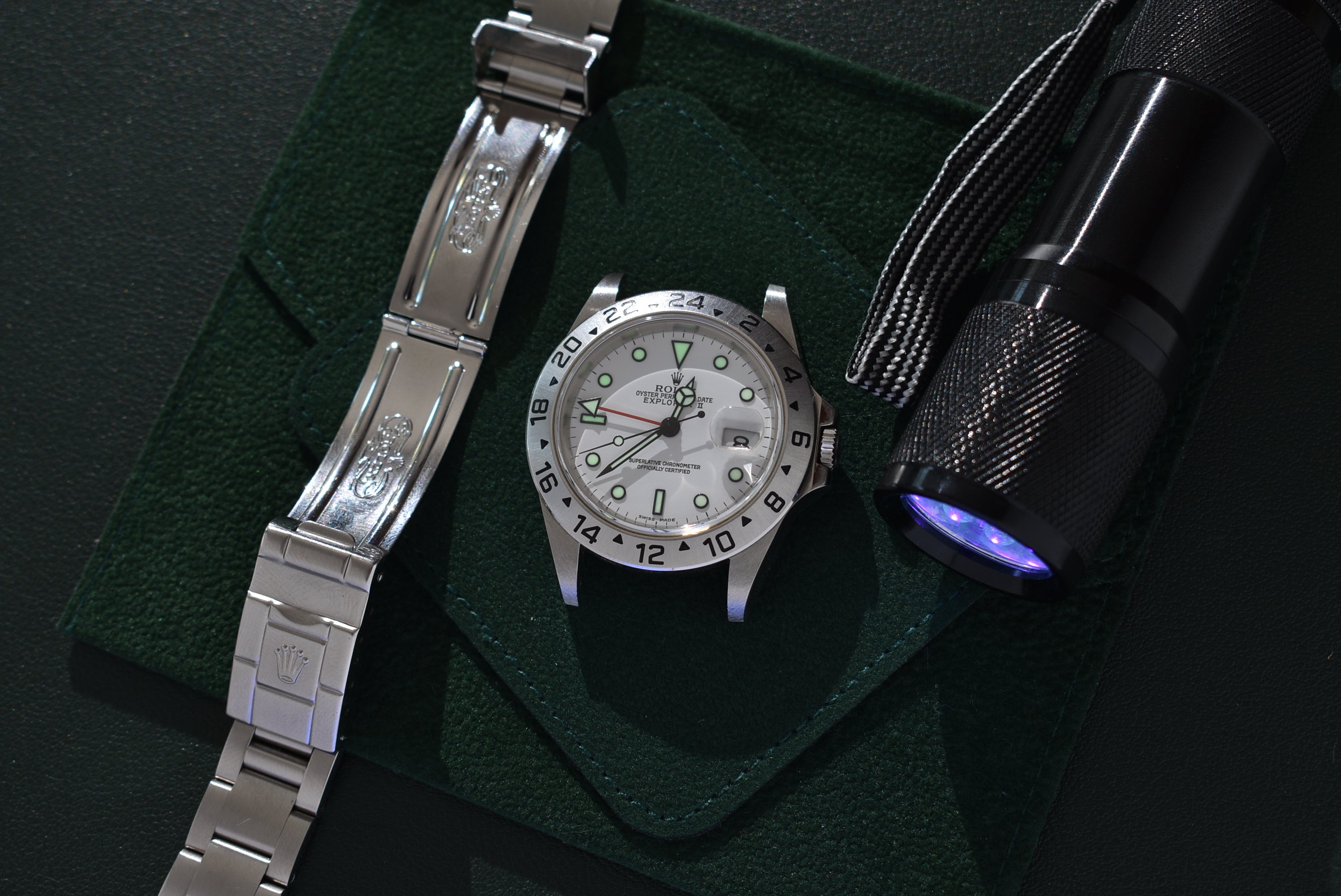
The Details
All our watches are scrutinized during inspection to make sure our descriptions are as accurate as possible.
- Related products
- Recently viewed
Cart
No more products available for purchase
Your Cart is Empty
Pair with
- 3802.73.51
- Boxes, Papers, Buckle
- Specifications
- The Story
- The Brand
Year: 1998
Model: Speedmaster
Case Diameter: 39mm
Lug to Lug: 45mm
Case: Stainless Steel
Dial: Pearl
Movement: Automatic
Condition
The case does have signs of wear but nothing major. The bezel is still nice and clear with some scratches from normal wear. The pearl dial has no cracks. The watch comes with the original box, which has dried up like many boxes from the era but is still in one piece. The watch also comes with the original buckle and warranty card.
The Omega Speedmaster range, a legendary collection of iconic chronographs, has captured the hearts of watch enthusiasts worldwide. The Speedmaster Reduced, introduced in the 1980s, aimed to cater to individuals with smaller wrists or those seeking a more wearable timepiece. Despite its reduced dimensions, the Speedmaster Reduced retained the signature elements that made the original Speedmaster an emblem of horological excellence.
The history of the Omega Speedmaster dates back to 1957 when the first Speedmaster model was launched. Designed as a robust and precise chronograph for motorsport enthusiasts, the Speedmaster quickly caught the attention of NASA and underwent rigorous testing for space missions. In 1965, it was officially chosen by NASA as the official watch for all manned space missions, making it the first watch to be worn on the moon during the Apollo 11 mission in 1969. This historic association with space exploration earned the Speedmaster the nickname "MoonWatch," solidifying its place as one of the most revered timepieces in history.
The Speedmaster Reduced shares the same pedigree and heritage as the MoonWatch but has some notable differences. The most apparent distinction lies in its size. The Speedmaster Reduced features a 39mm case, which is smaller than the 42mm size of the MoonWatch. This reduced size makes it more suitable for wearers with smaller wrists or those who prefer a more restrained and comfortable fit. Additionally, the Speedmaster Reduced houses an automatic movement, while the MoonWatch is equipped with a manual-winding movement. The automatic movement in the Reduced allows the watch to self-wind through the natural motion of the wrist, eliminating the need for manual winding daily. On the other hand, the manual-winding movement in the MoonWatch has a unique charm for watch enthusiasts who appreciate the traditional and tactile aspect of winding their timepieces.
The choice between the Omega Speedmaster Reduced and the MoonWatch ultimately comes down to personal preference and wrist size. Collectors and enthusiasts who appreciate the historical significance of the MoonWatch and its larger size may lean towards the classic model, while those seeking a more practical and everyday wearable timepiece with a smaller case size might find the Omega Speedmaster Reduced to be the perfect fit. Both watches exemplify Omega's commitment to craftsmanship, precision, and innovation, making them enduring symbols of horological excellence.
The example we have here is a limited release of the blue pearl dial Speedmaster Reduced. Only a handful of these were made, out of all the pearl dials, this is one of the more uncommon examples.
Omega, a Swiss watchmaker founded in 1848, has a rich history of innovation and precision. The company's vision was carried on by its sons Louis-Paul and César, who pioneered full watch production under the brand's roof. In 1894, the company unveiled the world's first mass-produced, interchangeable watch movement, the Omega Calibre, which streamlined production and propelled the brand to international fame.
As the 20th century began, Omega watches became at the forefront of timekeeping technology and revolutionized sports watches with their precision. The Olympic Games provided an ideal stage for Omega to demonstrate its exceptional timekeeping abilities. In 1932, Omega began its role as Official Olympic Timekeeper, starting an enduring partnership spanning over 80 years. With each Games, Omega introduced groundbreaking timekeeping innovations, such as the first photo finish camera at the 1948 London Olympics.
Omega's contributions to spaceflight began in 1962 when the Omega Speedmaster became the first watch worn in space on Mercury-Atlas 6. Its defining moment came in 1969 with the Apollo 11 moon landing, where Buzz Aldrin stepped onto the moon wearing his trusty Omega Speedmaster Moonwatch. The company played an indispensable role in NASA's pioneering '60s space missions, including the Apollo 13 mission, where the Speedmaster timed the engine burn, ensuring the crew's safe descent to Earth.
Omega's cultural impact extends into pop culture through a long-running cinematic partnership with James Bond Movies. Since 1995's GoldenEye, James Bond has sported Omega watches on the silver screen, wearing the Seamaster Diver 300M and the rugged Omega Seamaster Planet Ocean.
Omega remains dedicated to exploring new technological frontiers today, with innovations like the battery-free Pictograms model, wearable tech collaborations, and energy-harnessing movements driving progress and cementing its place in history.
